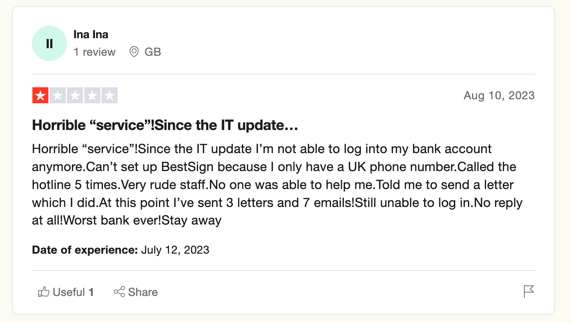Germany's largest financial institution, Deutsche Bank, acquired Postbank during the 2008 financial crisis. Fifteen years later, after a long and arduous process of data integration, riddled with mishaps and delays, the final phase of their mission was complete. Or, at least, they thought it was — until a tidal wave of customer complaints came crashing down.
Immediately following the integration, Postbank customers couldn't log in to their accounts or contact support centers. For several weeks, they were left without access to their funds, resulting in bounced payments, rejected debits, and credit scores in jeopardy. According to Reuters, the VZBZ consumer group registered over 1,700 complaints by Deutsche Bank's Pcomostbank and mortgage divisions for that year — a whopping 300 percent increase from the previous year.
On top of that, their Trustpilot reviews are spectacularly bad. We haven't seen customers rage this hard since Apple put that undeletable U2 album on the iPhone 6.


But wait — there's more! BaFin, the German financial regulator, received nearly 10,000 complaints about Postbank.
After a decade of major legal troubles, hefty fines, and money laundering charges, Deutsche Bank's reputation was already on shaky ground. To save face, they quickly hired 500 new employees, many of whom were customer support workers tasked with responding to masses of irate customers.
From a CX perspective, Deutsche Bank certainly failed in terms of foresight. Their existing customer service team wasn't equipped to handle a major crisis — after continuing a legacy of PR crises. Hiring hundreds of new workers helped resolve the issue (several weeks after the fact), but the damage was already done. What could Deutsche Bank have done differently to prevent utter catastrophe?
Deutsche Bank's Problem Goes Beyond Simple Tech Issues
After news of the Postbank debacle broke, Ramona Pop, head of VZBZ, confirmed that one in five of the 1700 complaints received were customer service-related.
"Banks are cutting more and more jobs, which also affects customer service, so consumers are ultimately helpless when problems arise," says Pop.
After they acquired Postbank, a company with millions of customers, you'd think maintaining a solid customer support team would be a no-brainer. Now, following their emergency hiring spree, the future of Postbank's customer support team remains to be determined.
Deutsche Bank just announced the upcoming closure of nearly half of all Postbank branches to position itself as a mobile-first provider. Now, it's not just the customers turning on Deutsche Bank — the employees are mad, too. This comes as no surprise, considering they only just recovered from handling a torrent of angry customer complaints.
"They would have expected to be rewarded for that, and now this news comes, which is a very, very big disappointment and a big shock for our employees," says Susanne Bleidt, head of the employee works council for Postbank branches.
Grab your popcorn, folks—watching this new era of Postbank unfold is bound to be interesting. Let's hope they've got a better handle on crisis communications, because, as it stands, they'll have to work pretty hard to regain public trust.
When it Comes to Crisis Management, a Solid CX Team is Your Secret Weapon
In the business world, a loyal customer is your greatest advocate. Trust is everything, and when that trust is broken — well, in the words of Ru Paul...

However, every good PR consultant knows that crisis management should start before a crisis occurs. An ounce of prevention is worth a pound of cure, and one of the best ways to prevent customers from jumping ship is by investing in stellar CX and CS teams right from the start.
If you've already built a reputation for having a customer service team that goes above and beyond, you'll be in much better shape following a PR blunder. Mistakes happen, and if people trust you, it'll be much easier to bounce back — especially if you're committed and clear about your plan to resolve the issue.
Want to learn more about the role of CX in times of calamity — whether it's PR-related or a full-scale global crisis? Read our blog on 6 Steps to Customer Experience Success During Crisis Times.

